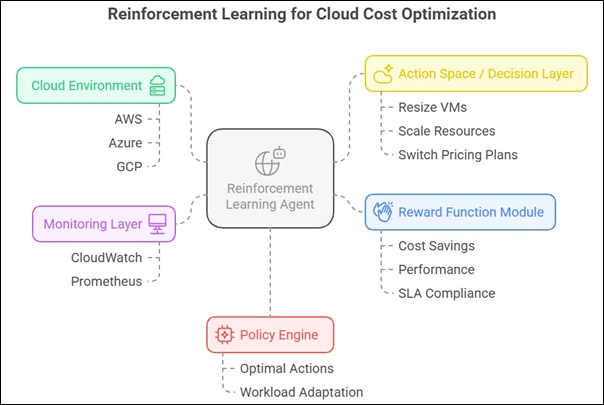|
Voiced by Amazon Polly |
Overview
As organizations scale their digital operations on the cloud, managing and optimizing costs becomes a critical challenge. While traditional cost optimization strategies focus on manual tuning or rule-based automation, a more intelligent and adaptive approach is gaining traction in Reinforcement Learning (RL).
This blog will explore how reinforcement learning can be leveraged to optimize cloud costs dynamically, reduce wastage, and drive efficiency in cloud environments.
Pioneers in Cloud Consulting & Migration Services
- Reduced infrastructural costs
- Accelerated application deployment
Understanding the Cost Challenge in the Cloud
Cloud platforms like AWS, Azure, and Google Cloud provide immense scalability and flexibility, but this comes with the complexity of managing usage-based pricing models. Some common cost-related challenges include:
- Overprovisioned resources (e.g., idle EC2 instances or oversized Kubernetes pods)
- Underutilized reserved instances or savings plans
- Sudden cost spikes due to traffic surges or misconfigurations
- Static cost rules that don’t adapt to workload patterns
These issues demand continuous monitoring and intelligent decision-making, which is where RL comes in.
Reinforcement Learning
In cloud cost optimization, the “environment” is the cloud infrastructure, and the “agent” can be a system that makes decisions like scaling instances, resizing VMs, or choosing spot vs. on-demand pricing.
Why Use Reinforcement Learning for Cloud Cost Optimization?
Unlike rule-based systems, RL offers several advantages:
- Adaptive Decision-Making: RL continuously learns from real-time data and adapts to changing workload patterns.
- Long-Term Optimization: Instead of minimizing immediate costs, RL can learn policies that optimize long-term outcomes, such as balancing cost with performance.
- Autonomous Control: RL agents can automate cost control decisions with minimal human intervention, reducing operational overhead.
Use Case Examples
- Autoscaling Cloud Resources
RL agents can learn optimal scaling policies based on application load and cost feedback, avoiding over-provisioning and reducing unnecessary spend.
- Spot Instance Management
RL can intelligently select and bid for spot instances, maximizing cost savings while minimizing the risk of instance termination.
- Storage Tiering
An RL-based system can learn to migrate data across storage tiers (e.g., S3 Standard to S3 Glacier) based on access frequency and storage costs.
- Container Resource Allocation
In Kubernetes environments, RL can dynamically adjust CPU/memory requests and limits for pods to reduce waste and improve efficiency.
Architecture Overview
An RL-based cost optimization solution typically includes:
- State Space: Current infrastructure metrics (CPU utilization, cost per instance, traffic, etc.)
- Action Space: Possible actions (scale up/down, instance type change, region migration)
- Reward Function: Cost savings, SLA compliance, or performance improvements
- Policy Engine: Trained RL model that recommends or executes actions
This system can be integrated with monitoring tools (e.g., Amazon CloudWatch, Prometheus) and actuation layers (e.g., AWS SDK, Terraform) for real-time optimization.

Challenges and Considerations
Implementing RL for cost optimization is not without challenges:
- Reward Design: Defining a balanced reward function that captures cost vs. performance trade-offs is crucial.
- Exploration vs. Exploitation: RL needs to explore various actions to learn, which might risk performance in production if not sandboxed.
- Training Time: RL models can take time to converge, especially in complex environments.
- Explainability: Unlike simple rule engines, RL decisions can be harder to interpret and justify to stakeholders.
These challenges can be mitigated using simulation-based training, offline reinforcement learning, and human-in-the-loop systems.
Conclusion
Reinforcement Learning brings a promising, intelligent, and autonomous approach to cloud cost optimization. It enables organizations to go beyond static rules and unlock real-time adaptability, learning, and efficiency in managing cloud infrastructure costs.
As cloud complexity grows, embracing RL-driven automation can lead to significant cost savings, better resource utilization, and a future-ready IT strategy.
Drop a query if you have any questions regarding Reinforcement Learning and we will get back to you quickly.
Empowering organizations to become ‘data driven’ enterprises with our Cloud experts.
- Reduced infrastructure costs
- Timely data-driven decisions
About CloudThat
CloudThat is an award-winning company and the first in India to offer cloud training and consulting services worldwide. As a Microsoft Solutions Partner, AWS Advanced Tier Training Partner, and Google Cloud Platform Partner, CloudThat has empowered over 850,000 professionals through 600+ cloud certifications winning global recognition for its training excellence including 20 MCT Trainers in Microsoft’s Global Top 100 and an impressive 12 awards in the last 8 years. CloudThat specializes in Cloud Migration, Data Platforms, DevOps, IoT, and cutting-edge technologies like Gen AI & AI/ML. It has delivered over 500 consulting projects for 250+ organizations in 30+ countries as it continues to empower professionals and enterprises to thrive in the digital-first world.
FAQs
1. How is reinforcement learning different from traditional cloud cost optimization techniques?
ANS: – Traditional methods rely on predefined rules or scheduled scripts. Reinforcement learning, on the other hand, learns from real-time data and adapts its strategies dynamically to optimize costs over time.
2. Can reinforcement learning be safely used in production environments?
ANS: – Yes, but it requires careful design. Many organizations start with simulations or shadow modes where RL agents make recommendations rather than direct changes, gradually moving to full automation.

WRITTEN BY Jay Valaki
Jay is a Research Associate at CloudThat with a strong interest in AI, cloud computing, and modern software development. He enjoys exploring innovative technologies, solving real-world problems, and contributing to impactful research. In his free time, he works on personal projects and stays updated with the latest tech trends.


 Login
Login


 July 29, 2025
July 29, 2025 PREV
PREV










Comments